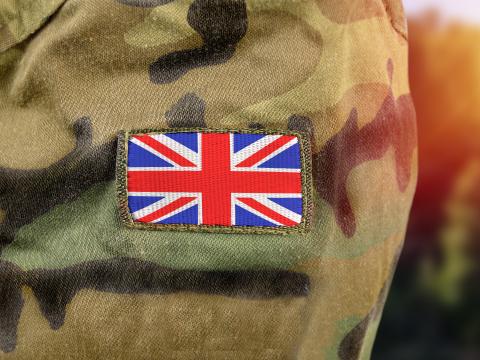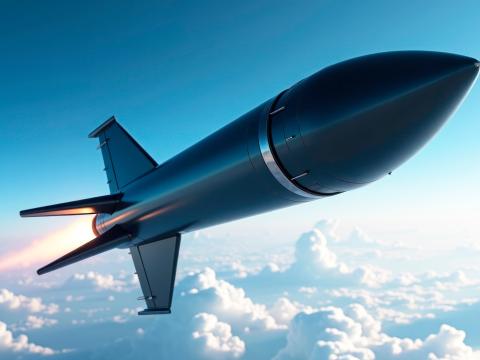Aerial View Sharpened By Data-Sharing System
The U.S. Air Force is examining technology that would enhance a B-1B Lancer crew's situational awareness while in the air and simultaneously record data that can be shared with other mission commanders or used to train future aircrews. The capability would provide pilots with information about existing threats, which would allow them to execute appropriate threat avoidance maneuvers.
Additional capabilities could improve mission effectiveness.
The U.S. Air Force is examining technology that would enhance a B-1B Lancer crew’s situational awareness while in the air and simultaneously record data that can be shared with other mission commanders or used to train future aircrews. The capability would provide pilots with information about existing threats, which would allow them to execute appropriate threat avoidance maneuvers.
Today’s B-1B aircrews cannot view real-time combat-essential data or record critical information to reconstruct hostile engagements with airborne interceptors, air-to-air missiles, ground-based radar systems, surface-to-air missiles or anti-aircraft artillery. An initiative currently underway at the Air Expeditionary Force (AEF) Battlelab, Mountain Home Air Force Base, Idaho, could change all that by allowing pilots to see images in real time on the systems control panel and on a full-screen flat panel display in the cockpit. Threat warning information would enhance reaction time and threat countermeasure effectiveness. In addition, the technology records the data so that it can be used to provide additional insight about the battlespace or to train aircrews.
The combat-essential data display and retrieval system (CEDDRS) features commercial and government off-the-shelf components that consist of a video camera, a dual-scan converter, a video quad multiplexer, a flat panel display, the control panel and a recorder. It would display mission data of four selected images as well as crew audio and the accurate time to the pilot and on the monitor at the offensive systems officer (OSO) or defensive systems officer (DSO) stations. Additionally, recording capabilities would capture this information for mission debriefing and intelligence gathering about enemy order of battle, tactics and other essential data.
According to Lt. Col. Michael G. Russell, USAF, director of bomber operations, AEF Battlelab, during current debriefings after a mission, pilots verbally explain what they observed during the flight. “They have means of detecting threats, but what this will give them is the ability to share what the plane sees through its sensors—what happened where in terms of time and space,” he explains.
Of the four images captured, displayed and recorded, the two DSO electronic display units, which show a panoramic format and threat situation format, may permanently occupy images one and two, the colonel says. These two formats would display ground and airborne threat identification and location, defensive order of battle locations, tail warning function alert data for all incoming missiles, countermeasure interactions, aircraft location on the navigation track line and bull’s eye data. However, he adds that the testing that currently is underway ultimately will determine how the four views would be employed best.
“CEDDRS can capture any data that comes into any of the cockpit displays and then convert it to video stream digitally and move it around to any of the screens,” he explains. The third and fourth images captured and displayed could include the DSO multifunctional display, the OSO multifunctional display, the pilot vertical situation display, the co-pilot vertical situation display, a laptop display or a pilot air-refueling/cockpit video camera image.
Although real-time situational awareness is one of the primary benefits of this technology, Col. Russell points out that the recorded data of actual missions could offer key advantages when used in training. “Instructors can sit down with students and say, ‘Crew, this is what happened on this mission,’ and they can replay what the recorder captured. It makes it easier for the instructors because they don’t have to reconstruct data from written notes,” the colonel relates. One of the goals of the current initiative is to determine whether recorded mission data enhances mission reconstruction for instructional purposes.
EDO Technical Services Operations (TSO), Lancaster, California, is the prime contractor on the project. According to Col. Russell, the company is providing the system as well as engineering services. The capabilities that the AEF Battlelab has been tasked with demonstrating are not all within one existing EDO TSO product; however, the company can modify existing technology, the colonel says. “Basically, everything is off the shelf except for cables and the pallet. This is a prototype that may be reduced into one box,” he adds.
AIL Systems formed TSO in 1977 to provide engineering, programming, flight test, avionics equipment repair and production testing for the B-1 Bomber. TSO began expanding its information technology support services into commercial business areas in 1988. Last year, AIL merged with EDO Corporation, and TSO was integrated into EDO.
TSO has been involved in several military projects. It supported Lockheed Martin Skunk Works in the development of infrared acquisition and designation system test program sets for the F-117. It performed block cycle updates for the AN/ALQ-161A software, including design, code, integration and testing of new functions into the Jovial code. TSO developed document conversion processes for the Air Force for online information and knowledge management.
In August, the battlelab received funding to pursue a demonstration of CEDDRS. Col. Russell estimates that work, testing and demonstration of the system will take 14 months. During that time, the CEDDRS team will determine if the technology will produce digitally recorded mission data and images about threats that enhance post-mission analysis, debriefing and intelligence gathering. It also will evaluate whether the displayed information enhances crew situational awareness.
Another goal of the demonstration is to ascertain whether the threat warnings shown on the pilot’s flat panel display result in quicker, more accurate countermeasures to corresponding threats as well as enhance mission effectiveness and weapons delivery.
Although the work being conducted by the AEF Battlelab focuses on incorporating CEDDRS capabilities into the B-1B, Col. Russell believes that the technology could be adapted to work in other aircraft as well. “Anything that has data streaming into it could use the technology because it can convert data into a digital video stream,” he offers.
Results from the tests on CEDDRS conducted at the AEF Battlelab will be reported to the Air Combat Command (ACC), Langley Air Force Base, Virginia. The ACC is currently examining options for upgrading the fleet and exploring what part technologies like CEDDRS would play.
“The idea is to demonstrate this capability, then others have to make the decision about proceeding with production. With all the other changes that are going to be made, they will coordinate the entire upgrade program. We are working closely with Air Combat Command headquarters’ B-1 people to make sure that this is a capability that they need and want.
“Obviously, when you take any system and the developers design it and the manufacturers produce it, you then look at how this equipment would be used and try to envision the future,” Col. Russell relates.
The speed of technology change is a challenge in systems such as CEDDRS as well as other planned upgrades. During the time between concept development and production, the technologies evolve so much that the services are always playing the catch-up game, the colonel allows.
“If the technology is mature, it makes it much easier. At the battlelab, we are trying to find mature technology so we don’t have to worry about the development of technology. We plug it in and see if it meets the needs. We try to marry up the technology with the need. CEDDRS is a medium need, but we believe it has military capability.
“Right now, the success of missions and the amount of information that can be shared during debriefings or used for training purposes is based on the aircrew’s experience level. It’s amazing what they can work around and still do an outstanding job. But anything that we can do that makes things simpler for the crew or makes them less task-saturated is a good thing,” Col. Russell states.
If CEDDRS tests demonstrate that the technology provides a needed capability, the ACC would determine if it would be installed in all B-1B aircraft or designed to be a plug-in equipment piece that would be taken on board when required. The AEF Battlelab also will work on a transition plan, the colonel explains, so if the Air Force decides to purchase the system, managers would have some ideas about how to move the technology into aircraft.
Initial testing of CEDDRS is planned for early 2002. The system will be mounted in an aircraft, and performance tests will be conducted. “We will fly a training mission that will have elements in it that are of interest to us to see if it records the data.
“We will give it to a test crew to determine if the system moves information around the cockpit and to see if it either helped or hindered their ability to do their jobs. That test crew is critical because a lot of the data we gather about the usefulness of CEDDRS will be concerning how it helped them. You can sit and review recorded data all day long, but unless it helped the crew, you really haven’t done anything,” Col. Russell declares.



Comments